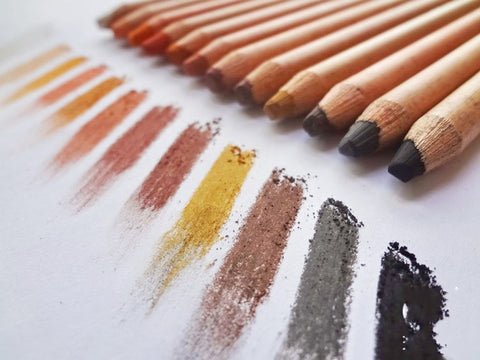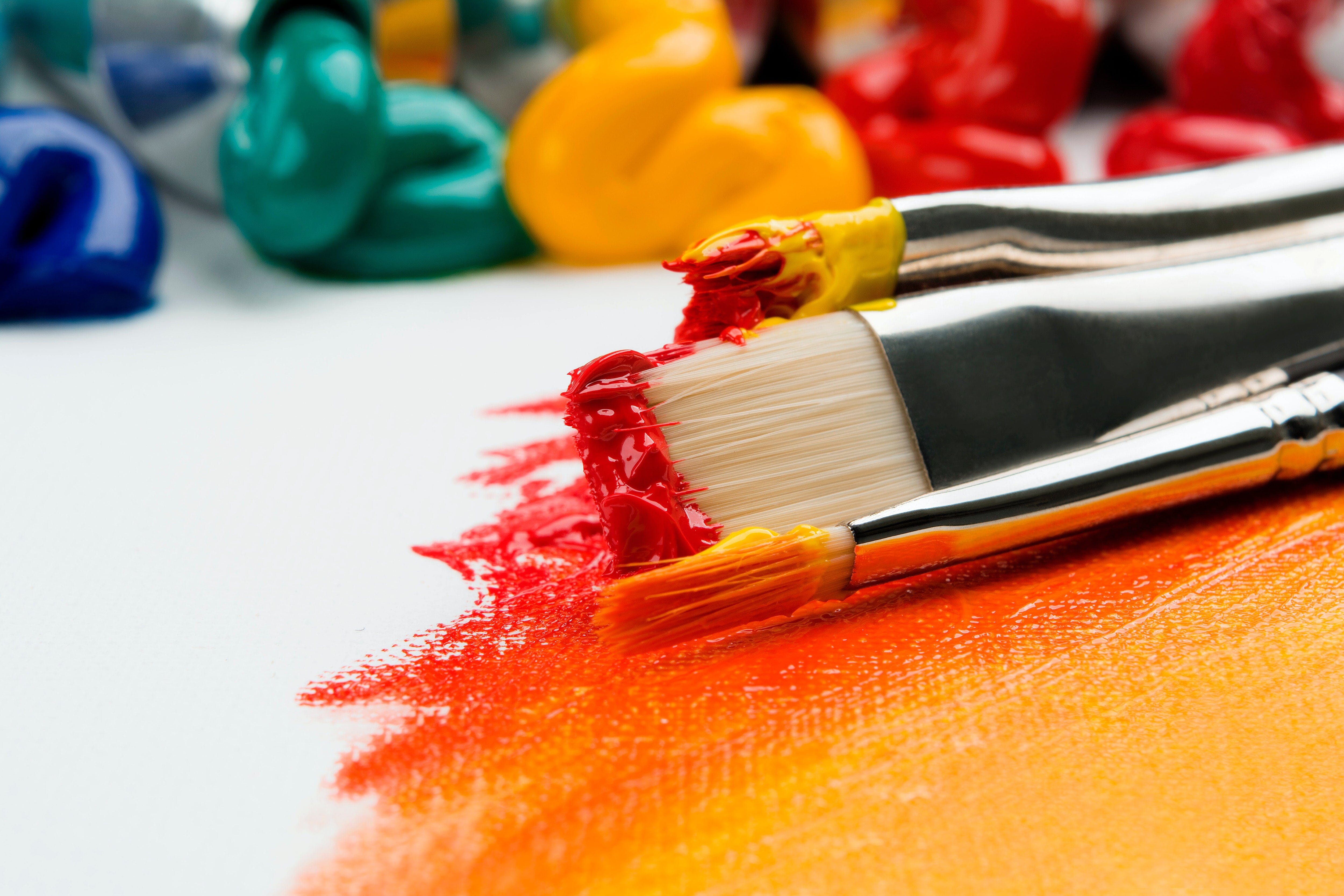
Like any love letter, it's hard to know where to begin!
Offering unsurpassed versatility, this medium has been such a good friend to me over the years. Our relationship has been repeatedly tested and fixative has never let me down; in fact, quite the opposite! Many times Workable Fixative has saved me from disaster (and heartbreak) and I don't know how any artist lives without it!
What is a Fixative?

A fixative is a topical spray that is applied to artwork to "fix" media in place, preventing smudging. Fixative is intended for use with pencils, charcoal and pastels on paper substrates. A number of different companies make fixatives, each offering their own benefits and drawbacks.
Although some fixatives are available in a non-aerosol pump spray (like SpectraFix) we'll be focusing on the the aerosol sprays which are the more versatile product.
What is Workable Fixative?
Workable Fixative is an aerosol spray manufactured by Krylon; workable means that this spray can be used to fix media in place through all stages of the artistic process (beginning, middle and end) allowing the artist to re-work areas without fear of smudging earlier stages.
"...But, I don't use charcoal or pastels so why would I need fixative?"
The Benefits...
When Painting on Canvas
- Fixative preserves your under-drawing

Many of us have had the frustrating experience of painstakingly sketching out a design onto canvas using pencil, then painting over the sketch only to have the graphite smear into the paint, muddying the colours and dissolving the details of the sketch.
Whether you're using pastel, charcoal, or pencil to do the initial sketch, smearing is always an issue once the painting begins. But it doesn't have to be! One good application of fixative and the problem is solved.
When Working with Watermedia on Paper
- Fixative enables safe over-painting
Using a workable fixative allows for techniques that were once entirely out of bounds for watercolours and ink (such as glazing). A major concern for many illustrators, watercolourists, and pen & ink artists is applying more colour (or more detail) over previous layers without bleeding or colour lifting.
Many watermedia artists also use white gouache as a sort of correction fluid to brighten up muddy spots and to restore the white of the page. Gouache as white-out works extremely well, but issues arise if more painting is necessary afterwards. Gouache is easily reactivated and will likely lift, smear and tint subsequent colour applications
A single application of fixative is all that is needed in order to safely rework or glaze an area that has been previously painted or touched up with white gouache.
|
Fixative Offers Added Versatility for Print Makers Workable fixative can also be a print-makers best friend! Personally, I love a hand painted monoprint; they're relatively easy to produce, easy to sell, and each print is unique because of it's hand painted detail. Many print-makers use water-based printing inks because they are fast drying, less expensive, and less toxic than oil based inks. However water-based inks are easily re-activated and will smear and bleed with even the smallest amount of added moisture. If you'd like to add some hand painted charm to your print just apply workable fixative first: problem solved!
Mammoth - Hand Painted Monoprint by Matt Bissett-Johnson |
Good to Know: If you're working on watercolour paper and want to fix an under-drawing before adding watercolour paint, please exercise caution. Applying a fixative will affect the absorbancy of your paper; making a cold pressed paper much slower to absorb (more like a hot pressed paper).
When You've Lost Your Tooth
- Fixative will help to regain a toothy work surface
When working with coloured pencil or graphite pencils, the tooth of the paper can eventually become loaded in pigment, refusing to accept anymore colour/graphite. This is quite frustrating, especially when the artist feels there is more work to be done before the piece is complete. Not knowing how to get around it, people will often just press harder on the pencil in an effort to force the colour to stick to the page.... but this doesn't work; it just permanently scores the page, making unsightly ripples.
As the paper is approaching that pigment saturation point, take a moment to lightly spray the piece with fixative. After its dry (about 3-5 min) it will readily accept more pencil.
Good to Know: if you apply a heavy layer of fixative to a drawing, the paper will become transparent as it becomes saturated in fixative. PLEASE DO NOT FREAK OUT. It's only temporary and as the solvent evaporates the paper will go back to normal and you'll never know the difference.
When Mixing Media
- Fixative allows you to break the rules, repercussion-free!
I work with mixed media because I love to break tradition! I genuinely couldn't work the way I do without workable fixative. Regardless of what substrate you're working on (whether it's paper, canvas or board) or what media you're working with, fixative makes almost anything possible.
Here is an example of how I incorporate fixative into my artistic process
- I'll do the under-drawing then spray fix it
- then go over it with watercolour and spray fix it
- I'll add some acrylics, and then spray fix the acrylic layer to add tooth
- I'll then add final texture and detail with either soft pastels or oil pastels
- and then several layers of fixative to finish it off
|
Just How Effective is Workable Fixative? I was hurriedly preparing for a gallery show and working on several pieces at once. I took a mixed media painting (acrylic with soft pastel on canvas) outside to spray it with fixative. I gave it a good spray, went back into the studio to continue working and promptly forgot about it. Some time later I looked outside and it was pouring rain. My heart sank and I prepared for the worst as I rushed outside to survey the damage. To my shock and surprise it looked just fine; it had lost zero chalk pastel detail! The water just beaded up and rolled off. I've been a devoted admirer ever since. |
When You Want Invisible Armour
- Fixative quietly provides all-around protection

Workable fixative is magical in the sense that it literally invisible. No matter what you're spraying, you'll never even know it's there. Fixative is neither matte nor gloss, it is just invisible... there's really no other way to explain it. Unlike many finishing sprays fixative doesn't create a film on top of your artwork, instead it's absorbed into the media and substrate providing an hidden barrier (much like sunscreen on skin).
if your artwork has been spray fixed and if it ever becomes dusty or dirty, its very easy to clean.
For artwork on paper: a white nylon eraser will do an excellent job of removing any dust, dirt smudges or finger prints but will not erase your fixed artwork!
For artwork on canvas: I have used a washcloth to scrub down a dirty mixed media piece (which featured a large amount of chalk pastel detail)... and nothing but the dirt came off.
| Alcohol Inks
Even why "dry" alcohol inks can remain tacky and collect dust, and are also very easy to scratch. Whether you're working with alcohol-based inks on synthetic papers or in a mixed media application, they usually necessitate framing behind glass for lasting protection. Alcohol ink on top of acrylic paint is a new and trendy mixed media combination, but finished pieces still have the same problems; delicate and prone to scuffing. Whether over acrylic or on synthetic paper, workable fixative is a great alternative to framing alcohol ink pieces. |
The Drawbacks...
- Toxic vapours and CFC's
This is easily the worst part of this product. Krylon products are all aerosols and are all quite smelly, but workable fixative has a particularly long lasting off-gassing effect which takes about 24 hours to dissipate. Workable fixative is also 100% not suitable for spraying indoors. (That would be instantly regrettable, don't do it.) I always use a proper respirator when spraying this, even outdoors, and I recommend you do the same.
As a consumer who is conscientious of the environment (and my own health), I have big issues with my love of this product. I've tried every healthier alternative option you can think of, but the fact remains that nothing does what workable fixative does. It's double edged sword so I do make efforts to keep its use to a minimum.
Ironically, this next drawback comes into play only when using fixative for it's intended purpose; fixing pastels
- Pastel colours will dull/darken/washout
There are two ways to combat this:
- Use fixative from the ground up, stopping often to apply fixative as you go. Your piece will be all the more fixed and stable at the end of it, and the journey will be less frustrating/more rewarding.
- Use the best quality of pastels that your budget can afford. It's the chalk or clay fillers used in some pastels that cause a lot of the problems when it comes to fixative.






